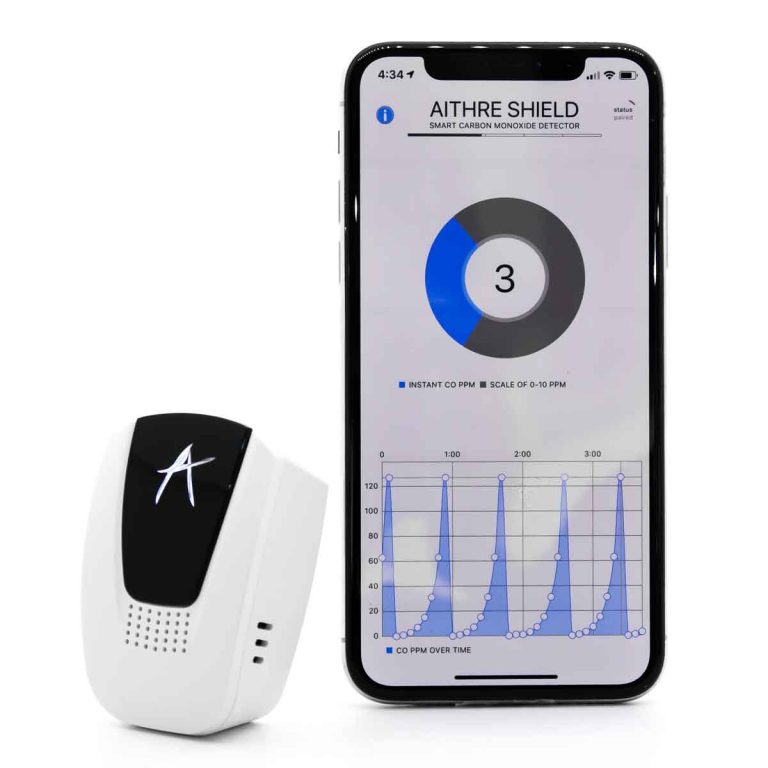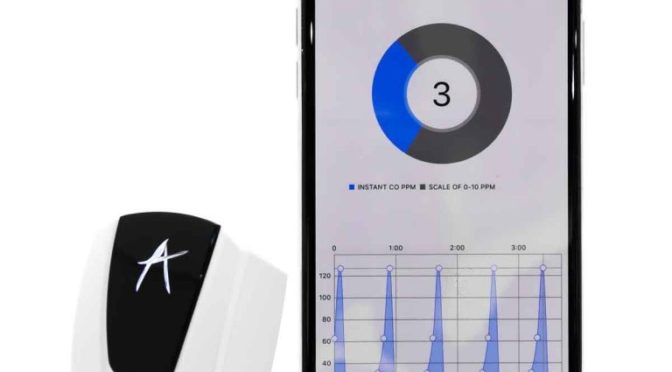
Carbon monoxide poisoning is an ever-present threat in piston airplanes, especially in winter when heating systems can introduce the deadly exhaust gas into the cabin. I know – I experienced just such a scenario last fall. Fortunately I was saved by a good CO detector, which I use religiously. While the standalone Tocsin 3 is still a great choice, there’s another option new to the market that includes a smartphone app for additional monitoring. Here’s a look at what it can do.

The new Aithre Shield was designed by a group of RV pilots to offer more precise monitoring of cockpit conditions and more choices for alerting. The electrochemical sensor does not require any calibration for 10 years, is accurate to within 1 part per million (ppm), and we found it to be very responsive – Aithre says within 30 seconds and we agree. The sensor is also insensitive to pressure and temperature changes, so it’s well-suited to the cockpit.
The sensor has just a single on/off switch on the back and a built-in rechargeable battery. Included in the package is a charging cable and charging clip – just snap the Aithre Shield onto the clip to charge it up. When it’s time to fly, you can snap it onto a second clip, this one without the charging port but with a hole that allows for it to be mounted to the panel. This works reasonably well, but we found a little Velcro is about as good. Since the sensor is only about 2″ tall and weighs about an ounce, it’s easy to mount almost anywhere.
The front of the Aithre Shield has a transparent A logo that changes colors (blue, amber, red) depending on the CO level. On a sunny day, the warning light wasn’t as bright as we would prefer, but it was visible. There’s also a fairly loud beep that comes on above 50 ppm.
The real benefit, though, is the free iOS companion app. It uses Bluetooth Low Energy (BLE) so it’s really easy to use. Just turn on the sensor and open the app; your phone will connect automatically and stay connected, with no pairing or passwords. It’s dead simple. The app shows the current CO level at the top of the screen, as well as the trend over the last 15 minutes. This is surprisingly helpful at reducing nuisance alerts: was that a fluke reading or is there a consistently rising trend?
The alert level can be modified by the user if you prefer. Simply tap the i symbol at the top left of the screen and adjust the slider.
You can even get audio alerts from the app if you pair your phone to your aviation headset (here’s how). Siri will give spoken warnings at 2 ppm, 10 ppm, and 50 ppm (or whatever value you choose in the settings).
Overall, we found the Aithre Shield to be an easy-to-use, reliable carbon monoxide detector. As a standalone device, it’s not quite as loud as the Tocsin 3 mentioned above, but the addition of the app is a great upgrade. It’s worth pointing out that carbon monoxide poisoning is not exclusively a threat in cold weather. Many older airplanes have small leaks from the engine compartment that can be dangerous on a long flight. Whichever device you use, make sure you’re flying with one.
The Aithre Shield is available for $180, including both the mounting clips and charging cable. You can download the app for free on the iTunes App Store.
The post Aithre releases new carbon monoxide detector and app appeared first on iPad Pilot News.
Source: Ipad appsAithre releases new carbon monoxide detector and app


